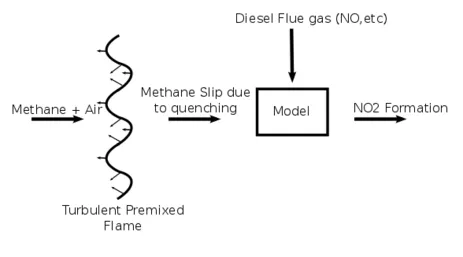Numerical Simulation of NO to NO2 Conversion in Dual Fuel Engines
Supervisor | Subject |
|---|---|
Editor | Cooperation/Funding |
| Prof. Dr.-Ing. Thomas Sattelmayer | Dual Fuel Engines, Combustion Modeling, Pollutant Emissions |
| Ehsan Arabian, M.Sc. | HERCULES 2, EU Project |
Motivation
In order to tackle the challenges of the upcoming strict regulations regarding the efficiency and also the pollutant emissions such NOx of marine Engines an EU Funded Project has been initiated. According to this Europewide project, the Reciprocating Engines should be investigated from different points of views. This includes amongst others investigating of new combustion concepts and improving the fuel flexibility by using different kinds of fuel such as Biofuels, LNG etc. In order to reach this flexibility the different phenomenon of injection, ignition, combustion, and emission should be understood and also optimized. A promising concept to reduce NOx emissions is the so-called Dual Fuel combustion, in which a lean charge of Methane/Air gets ignited through a smaller amount of Diesel (pilot flame). Due to the potential lower temperature than the conventional Diesel Engines the formation of NOx is lower. On the other sides, there is some methane slip, because the premixed flame quenches. The mixing of the resulting unburnt hydrocarbons with the existing NO results to NO2 formation, which is characterized as yellow smoke. According to the project at the chair of Thermodynamics, the conversion of NO to NO2 should be understood and numerical simulated.
Numerical Method
Kinetics calculation is the key point of NO2 modeling, which gets implemented in open source software Cantera. Through calculation in 0D. reactors in Cantera, one is able to analyze the sensitivity of the NO2 formation regarding different temperatures, pressures and mole fractions and gets the first impression which reaction affects the NO2 formation mostly. The first results in Cantera show that NO2 is driven by the unburnt hydrocarbons and existing NO by low temperatures. Besides the kinetics, the effect of fluid dynamic on NO2 formation has to get investigated via CFD calculations. The latter is done via AVL Fire, which is widespread for engine designs.
The challenge of CFD calculation of reactive flows is amongst others considering the effect of turbulence on the formation of NO2. To tackle this problem an approach should be developed, which considers the effect of kinetics and the turbulence on the NO2 formation species.
